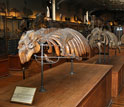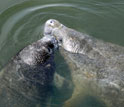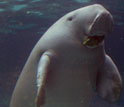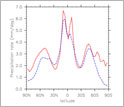News Release 11-084
Fossil Sirenians Give Scientists New Look at Ancient Climate
Change view of water temperature during time when first modern mammals emerged
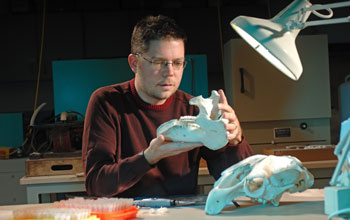
Geologist Mark Clementz samples tooth enamel from molars in the lower jaw of a Florida manatee.
April 21, 2011
This material is available primarily for archival purposes. Telephone numbers or other contact information may be out of date; please see current contact information at media contacts.
What tales they tell of their former lives, these old bones of sirenians, relatives of today's dugongs and manatees.
And now, geologists have found, they tell of the waters in which they swam.
While researching the evolutionary ecology of ancient sirenians--commonly known as sea cows--scientist Mark Clementz and colleagues unexpectedly stumbled across data that could change the view of climate during the Eocene Epoch, some 50 million years ago.
Clementz, from the University of Wyoming, published the results in a paper in this week's issue of the journal Science.
He and co-author Jacob Sewall of Kutztown University in Pennsylvania used their findings to dispute a popular scientific assumption about the temperature and composition of seawater during the time marked by the emergence of the first modern mammals.
The Sirenia, named for the sirens or mermaids of Greek myth, is an order of aquatic, plant-eating mammals that live in swamps, rivers, estuaries, marine wetlands and coastal waters.
Four species of "sea cows" are alive today, in two families and genera: the dugong, with one species, and manatees with three species.
Sirenia also includes the Steller's sea cow, extinct since the 18th century, and others known only from fossil remains. The order evolved during the Eocene more than 50 million years ago.
In their paper--"Latitudinal Gradients in Greenhouse Seawater δ18O: Evidence from Eocene Sirenian Tooth Enamel"--the scientists used the isotopic composition of sirenian fossils from a broad time period and geographic area, along with climate simulation data, to add to the long-running debate over Eocene climate.
"This study demonstrates the value of the fossil record, and of examining the deep time record of paleoclimatological events, so we can better understand climate change today," says Lisa Boush, program director in the National Science Foundation (NSF)'s Division of Earth Sciences, which funded the research.
"This novel approach will potentially transform our way of thinking about the hydrologic response to global climate change."
"I wasn't looking at it from this direction when we started the project," says Clementz, whose research is part of an NSF CAREER award.
"But once we started accumulating enough samples, we could step back and get a better understanding of the habitat and dietary preferences of these fossil species, and also of the big picture. We saw that it could be reflecting climate and environmental change."
A new look at climate during the Eocene, when Earth underwent a dramatic change, could help scientists better understand global climate change today.
Most scientists assumed that the oxygen isotopic composition of seawater in the past was very similar to that of today, with high values at low latitudes and low values at high latitudes.
Isotopes are variants of atoms of a particular chemical element, in this case oxygen, with differing numbers of neutrons.
"But when we looked at the oxygen isotopic values of the fossils from low-latitude sites for the Eocene, they were much lower than we would predict," says Clementz.
The finding suggests that low-latitude sites during the Eocene were much wetter than today.
"This created a very different distribution in the oxygen isotopic composition of seawater for this time interval, which would, in turn, significantly impact estimates of paleoclimate and paleotemperature in the distant past," says Clementz.
"Scientists have used this assumption of the oxygen isotopic values of seawater to constrain temperature estimates for the past."
In their paper, Clementz and Sewall show that the assumption may be flawed, which could mean that previous estimates of water temperature are incorrect.
-NSF-
-
A fossil sirenian, Halitherium schinzi, at the Paris National Museum of Natural History.
Credit and Larger Version -
Manatees swim in Florida waters; their ancient relatives tell a story of climate change.
Credit and Larger Version -
A modern-day member of the Sirenia--a dugong--at the Sydney, Australia, aquarium.
Credit and Larger Version -
Scientists Jacob Sewall and Elizabeth Heness analyze climate change simulations.
Credit and Larger Version -
A comparison of zonally-averaged precipitation for the Eocene (red) and modern times (blue-dashed).
Credit and Larger Version -
The researchers' work is described in the April 22, 2011 issue of the journal Science.
Credit and Larger Version
Media Contacts
Cheryl Dybas, NSF, (703) 292-7734, email: cdybas@nsf.gov
Steve Kiggins, University of Wyoming, (307) 766-2353, email: skiggin1@uwyo.edu
The U.S. National Science Foundation propels the nation forward by advancing fundamental research in all fields of science and engineering. NSF supports research and people by providing facilities, instruments and funding to support their ingenuity and sustain the U.S. as a global leader in research and innovation. With a fiscal year 2023 budget of $9.5 billion, NSF funds reach all 50 states through grants to nearly 2,000 colleges, universities and institutions. Each year, NSF receives more than 40,000 competitive proposals and makes about 11,000 new awards. Those awards include support for cooperative research with industry, Arctic and Antarctic research and operations, and U.S. participation in international scientific efforts.
Connect with us online
NSF website: nsf.gov
NSF News: nsf.gov/news
For News Media: nsf.gov/news/newsroom
Statistics: nsf.gov/statistics/
Awards database: nsf.gov/awardsearch/
Follow us on social
Twitter: twitter.com/NSF
Facebook: facebook.com/US.NSF
Instagram: instagram.com/nsfgov



